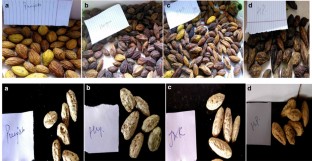Propagation of Terminalia chebula from explants and seeds collected from different agro-ecological regions of north-western states of India
Research Articles | Published: 03 August, 2021
Online ISSN : 2229-4473.
Website:www.vegetosindia.org
Pub Email: contact@vegetosindia.org
First Page: 158
Last Page: 167
Views: 1137
Keywords:
Seed, Dormancy, Germination, Micropropagtion, Terminalia
Abstract
Seeds of Terminalia chebula, collected from Punjab and adjoining states of Haryana, Himachal Pradesh and Jammu and Kashmir were subjected to different pre-sowing seed treatments to overcome dormancy. The fruits from different locations had different shapes and sizes but the taste and odour was same. The fruits and seeds from Haryana were big and heavier than other locations. The seeds of Punjab and Haryana exhibited higher germination. The pre-sowing treatment with 50% concentrated sulphuric acid for 2 min was most effective to enhance germination. Seed vigour and seedling recovery per cent declined with storage and enhanced with treatment of concentrated sulphuric acid followed by boiling water, cold water and cowdung slurry treatments. The results for micro-propagation of T. chebula revealed that MS + BAP (6-benzylaminopurine 1 mg/l) + kinetin (0.5 mg/l) + GA3 (0.5 mg/l) + charcoal (0.4 g/l) media promoted maximum bud break (71.63%), mean shoot length (25.00 mm) and number of shoots per explant (1.60).

(*Only SPR Members can get full access. Click Here to Apply and get access)
References
Anjaneyulu C, Giri CC (2008) Factors influencing somatic embryo maturation, high frequency germination and plantlet formation in Terminalia chebula Retz. Plant Biotechnol Rep 2:153–161
Aryee FNA, Oduro I, Ellis WO, Afuakwa JJ (2006) The physicochemical properties of Xour samples from the roots of 31 varieties of cassava. Food Control 17:916–922
Bagul RM (2017) Biodiversity of tree species with special reference to rare, endangered and threatened plants species of Padmalaya forest region of Jalgaon district (MS), India. Plant Arch 17(2):866–868
Chakraborty AK, Pandey ON, Bhardwaj SD (1992) Presowing treatment on seeds of Terminalia bellirica. J Res Birsa Agric Univ 4(1):95–98
Chander J, Chauhan SK (2014) Current status of management of Harar (Terminalia chebula Retz.) in Shiwalik hills. J KrishiVigayan 3:13–17
Chauhan SK, Sharma R (1997) Seedling quality evaluation: importance in afforestation. Adv for Res India 17:59–72
Chauhan SK, Srinidhi HV, Sharma R, Chander J, Saralch HS (2017) Trends in forest tree seed germination research. In: Shukla G, Pala AD, Chakraborty S (eds) Forest seed science and management. New India Publishing Agency, New Delhi, pp 131–153
Dash B (1991) Materia medica of ayurveda. B. Jain Publishers, New Delhi, pp 170–174
Deshmukh AJ, Kanwar K, Narkhede SS (2005) Effect of growth regulators on in vitro culture of Terminalia chebula Retz. New Agric 16:29–36
Dhillon HS, Thakur AK, Singh K (2014) Growth and propagation aspects of some medicinally important trees in Chandigarh, India: a review. J Med Plant Stu 25:29–35
Gill LS, Hussaini SWH, Musa AH (1986) Germination biology of some Cassia spp. (Leguminosae). Legume Res 5:18–24
Gowthami R, Sharma N, Pandey R, Agrawal A (2021) Status and consolidated list of threatened medicinal plants of India. Genet Resour Crop Evol 25:1–29
Hamsa R (2015) Studies on seed germination and seedling growth of Terminalia chebula Retz. M.Sc. thesis, University of Agricultural Sciences, Bengaluru, India.
Haslegrubler P, Krautzer B, Blaschka A, Graiss W, Potsch EM (2013) Quality and germination capacity of seed material harvested from Arrhenatherion meadow. Grass Forage Sci 69:764–776
ISTA (2008) International rules for seed testing. International Seed Testing Association (ISTA), Bassersdorf
Kaur J, Sharma R, Sharma P (2020) Effect of storage on biochemical constituents of Terminalia chebula Retz. fruits collected from different sources in India. Acad J Med Plants 8(1):005–010. https://doi.org/10.15413/ajmp.2018.0190
Kumar D (2015) Ecological and genetic variation among natural populations of Terminalia chebula Retz., Ph.D thesis, Dr Yashwant Singh Parmar University of Horticulture and Forestry, Nauni, Solan, India.
Luna RK (1996) Plantation trees. International Book Distributors, Dehradun
Murashige T, Skoog F (1962) A revised medium for rapid growth and bio assays with tobacco tissue cultures. Physiol Plant 15:473–497
Pandonou EA, Kassa B, Assogbadjo AE, Chakeredza S, Babatounde B, Kakai RG (2013) Differences in germination capacity and seedling growth between different seed morphotypes of Afzelia Africana Sm. In Benin (West Africa). J HortiSci Biotech 88:679–684
Pellati F, Bruni R, Righi D, Grandini A, Tognolini M, Prencipe FP, Poli F, Benvenuti S, Rio DD, Rossi D (2013) Metabolite profiling of polyphenols in a Terminalia chebula Retizus ayurvedic decoction and evaluation of its chemopreventive activity. J Ethnopharmacol 147:277–285
Ratha KK, Joshi GC (2013) Haritaki (Chebulic myrobalan) and its varieties. AYU 34:331–334
Sanjeewa TABD, Pushpakumara DKNG, Sangakkara UR (2013) Morphological characterization of Terminalia chebula Retz.in Sri Lanka. Trop Agric Res 25:127–132
Singh U, Wadhwani AM, Johir BM (1965) Dictionary of Economic Plants in India. New Delhi, Indian Council of Agricultural Research, p 288
Troup RS (1921) Silviculture of Indian trees. International Book Depot, Dehradun, p 1195
Verma KS, Baksh Z (2006) Antidote ailments—through medicinal plants—as observed in tribals of Jabalpur district. Visleshana 10:15–17
Verma YS, Kanwar K, Bhardwaj SV (2013) Regeneration and transformation studies in Terminalia chebula Retz. J Sci Ind Res 72:563–571
Acknowledgements
The facilities provided by plant tissue culture laboratory, School of Agricultural Biotechnology, PAU, Ludhiana for the research experiment are duly acknowledged.
Author Information
Department of Botany, Punjab Agricultural University, Ludhiana, India
ravneet-bot@pau.edu